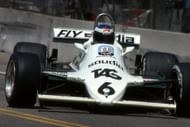Actually, the qualifying format has gone significant changes down the years and before 1996, there used to be two sessions- one on Friday and one on Saturday with the fastest times set across the two days deciding the grid positions. Taking advantage of the rule and being absolutely convinced that the higher temperatures wouldn’t allow better laptimes both Lotus and Toleman opted to keep both their cars in the cooler conditions of the garage. Joining them were Francois Hesnault and the two drivers who had crashed earlier in the weekend- Martin Brundle and Philippe Alliot.
Lotus had a front row lockout courtesy of their times on Friday. Championship leaders Alain Prost and Niki Lauda were well down but even behind them was the Flying Finn Keke Rosberg who had a trick up his sleeve.
The melodrama reached its climax on Sunday morning when Williams driver Jacques Laffite showed up in the paddock in- hold your breath- pyjamas! That along with the track needing repairs after suffering damage during a Can-Am race on Saturday caused the pre-race warm-up to be cancelled.
After all the hullabaloo, the race finally got underway at 1100 hrs local time- a change from the normal late afternoon starting time just to avoid the heat. Everybody hoped that this would be the end of the difficulties caused by the heat but the sultry weather would play a final role towards the end of the race which would give rise to one of the most iconic scenes in the history of the sport.
Nigel Mansell led early on from his teammate de Angelis before the Italian suffered an engine misfire. Meanwhile, René Arnoux’s Ferrari had stalled on the grid forcing him to start from the back of the pack. As the race progressed, either the car failed or the driver lost concentration and collided with the barriers.
The results show 12 drivers “spun off” and retired. Among all of that, the track surface was deteriorating all the time. Although earlier in the race Alain Prost had shown his customary cool and preserved his tyres to mount a charge later in the race which, infact, he was successful in, to some extent, he had a momentary lapse in concentration and that was enough to send him into retirement. If the sweltering temperatures could claim a guy like Alain Prost, surely nobody else would stand a chance?
After what Keke Rosberg did that day, maybe the title ‘Iceman’ would have suited him more. Having started 8th, he slowly made his way up through the field up to 2nd and pounced when Mansell hit the barriers and had to pit for damage repairs. From then on the Finn would never relinquish the lead and take the chequered flag to cap off a truly dramatic weekend. Remember we talked about Rosberg having a trick up his sleeve? Here’s what it was. He had used a water-cooled helmet to keep his head cool during the race. More fitting for an ‘Iceman’ than having an ice-cream on a rainy day. Isn’t it?
Along with Rosberg, another driver who deserves mention is French driver René Arnoux. After having stalled on the grid, he made his way up from 26th to 2nd at the finish some 20 seconds behind Rosberg. Whether his performance was more spectacular than Rosberg’s is debatable but no doubt those two were the stars of the weekend. Along with our pyjama-man Laffite of course!
One final bit of drama involved none other than F1′s drama king Nigel Mansell. Having run out of fuel on the start-finish straight with 3 laps to go, Mansell tried pushing his car over the line but failed and collapsed right there on the track giving us one of the most memorable incidents in the sport’s history.
The Dallas Grand Prix was replaced in 1985 by the Australian Grand Prix held at the challenging Adelaide circuit. Although Adelaide itself gave us some wonderful races, no other track could give us so much drama during a single weekend. The race in Dallas stands out among the generally dull races held in the USA- an ostrich race drew more spectators than an F1 race in Phoenix in 1991.
Austin brought in a fresh air of hope with an excellent race last year and combined with the extremely good facilities was labelled as one of the best, if not the best, race of the year. As Formula 1 continues to make its mark on a market which was strangely not embraced it in more than 50 years of its presence, we hope that the new track in New Jersey lives up to the hype and continues the tradition along with Austin in bringing the sport to more American homes in the future.

